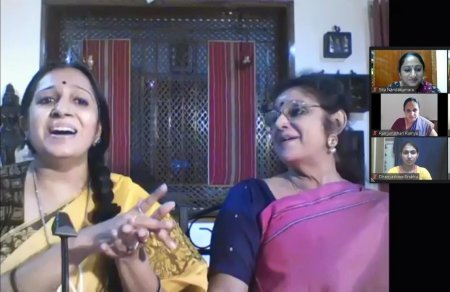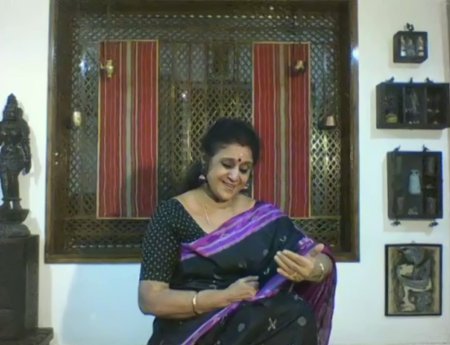
|   |

|   |
Interplay of the subtle and the suggestive - Lakshmi Girish e-mail: lakshmigirish02@gmail.com October 21, 2021 "The body is the temple of the soul. Open your eyes, mind and heart and dance to find the silence within." Five days of the MANTHANA 2021 series with Chitra Visweswaran was one of the most immersive, intense experiences of self-discovery. Abhinaya, in a new dimension and approach like never before, interwoven with the intuitive mind was a refreshing revelation, at the end of the workshop. Organised by Radhika Shetty, Founder/Director of Nrityaangan, along with the able assistance of Uma Satyanarayanan and Sukanya, the workshop was a delightful experience now deeply embedded in our minds.  Uma Satyanarayanan and Chitra Visweswaran What seemed to flow effortlessly from the veteran was explained to the minutest detail - the process of abhinaya without really approaching it as a process itself. Everything from understanding the literature, to treating the text to bring it into the performance, and to really immerse and soak in it was felt, right from the first moment of our interaction. As though she read the minds of the participants, Chitra Visweswaran started off with the Lakshana Granthas. Talking about the texts of dance, it made great sense to understand and approach the various Lakshana Granthas as contextual, essentially recording and understanding what was, at that time period. The importance of studying them and understanding them in that context was a fresh approach. The important thing however is to convey one's intent without getting caught in the literal word itself. A lot of learning needs to happen with the text and the context before one can really immerse into the character or the literature. How effortlessly she brought about this seemingly complex task by asking us to become like a hamsam (swan) left us awestruck. "Be like the hamsam and take only what is necessary," was a profound lesson in itself. There is a delicate balance that needs to be maintained between the learner or the seeker and the dancer. Learn and approach the literature like a student but bear in mind, the artiste in you, while thinking from the perspective of the author. Be true to the text while under study, but while dancing keep the scholar inside you, away. Eventually, there needs to be a dialogue that emerges out of the narrative and we must cultivate the sensibility to become the narrator and the narrative must be as per the portrayal. Intertwining one's understanding and imagination with one's observation is the key to bring about an effective and affirmative portrayal. The biggest inspiration should be nature itself, and when she urged us to link the nature around with the life it beholds, bringing our understanding and imagination into it, we unearthed a whole new perspective. It was interesting to understand how this observation could inspire one. The inspiration drawn from nature and life around would transcend into one's creativity through what is called the process of osmosis. The beautiful realisation of how osmosis nourishes creativity was the greatest takeaway for us. The importance of using the entire body to emote was visually emphasised in the smallest portrayal of characters or situation. The beauty of the subtle and the suggestive, in each movement, be it internal or external was elegance personified.The characters were etched deeply in our minds as she effortlessly traversed through them with just a stance, a walk, a glance, a swing of the head or the twist of a wrist. The apparent and the suggestive seemed to juggle to such precision that the context and the character unfolded itself before us as she demonstrated along. In the words of Chitra Visweswaran, there should be a necessity for movement which translates into a very powerful word called auchithyam which by far, falls short of a precise definition in the English language.There should be a control and a measure for everything. The pivotal factor is to immerse oneself into the performance without really forgetting oneself. What we understand was, choreography is an immersive, indulging, surrendering process that finally unleashes the creativity in each person. It is also seeking and understanding of ourselves in a deeper way and one which transcends on stage. We bring our collective consciousness into a piece under choreography and at times, also smear it with droplets of wisdom that we acquire in the process of seeking and surrendering to it. Once a piece is choreographed, the veteran opines that we need to let it settle in for some time and then approach it again. This might or might not change the perspective in which one approached it earlier. This was indeed a very beautiful takeaway, especially in these fast paced times of dance productions staged online and offline. The whole process of dancing is nothing but channelizing the flow of energy above and below, with the tools of the body and the mind. When each of us performs this process called dance, seldom do we realise that we draw in energy from the space above and the space below us. The way each hastha or each stance of the feet is put to use, this cosmic energy connects with us or we establish a connection with the energy source. In her words, the palms and the soles of the feet are the cosmic connectors and the way they are placed in a movement is what brings out the energy and the aesthetics. It unfolded before us when she said, "Any art form, especially dance has to energise the space around"; it was contagious, indeed.  Chitra Visweswaran It is easy for a dancer to get lost in the music that engulfs her or him - perceiving the music in its totality so that its flavour transcends into the being of the dancer. The laya of the music sets the tone for the dance and the dancer equally. Getting the right music in place for the portrayal is the core of the performance. It is essential to understand the ragas and their flavours and their contextual usage and it's crucial to get this right. A dancer has to be a good reader and should literally love the smell of books. The words do form a conversation with you, once you get deeply involved, be it prose or poetry. Understanding the text deeply from a scholar's perspective and churning it in our minds fuelled by our imagination, observation and interpretation is the true seeking. Seeking earnestly and surrendering one's ego completely to the art is a divine experience. A complete surrender to the art form when your inner voice chants "the art is always greater than the artiste" is a true representation of Indian art forms. They were awe inspiring words when the esteemed artiste spoke with such conviction and being true to herself. It all seemed to make perfect sense when she said that when dancing, the dancer should be a rasika and enjoy it, immerse in it, but not to forget oneself in it. The journey that she took us through was one beyond time and space. What we experienced was a glimpse of how to approach each composition with one's own thrust, as she puts it across. Each of the participants enacted the compositions in their familiar thrust and internalisation each day, and at the end of it, a new perspective emerged. Her words that echo in our being, "Develop the seeing eye and the hearing ear. Remove the blinkers in your eyes and the stops in your ears. The stage is the canvas and the body is your paint brush. Use your tools to create the painting. The little done and more undone." Lakshmi Girish is a Mohiniyattam dancer based out of Bengaluru. |